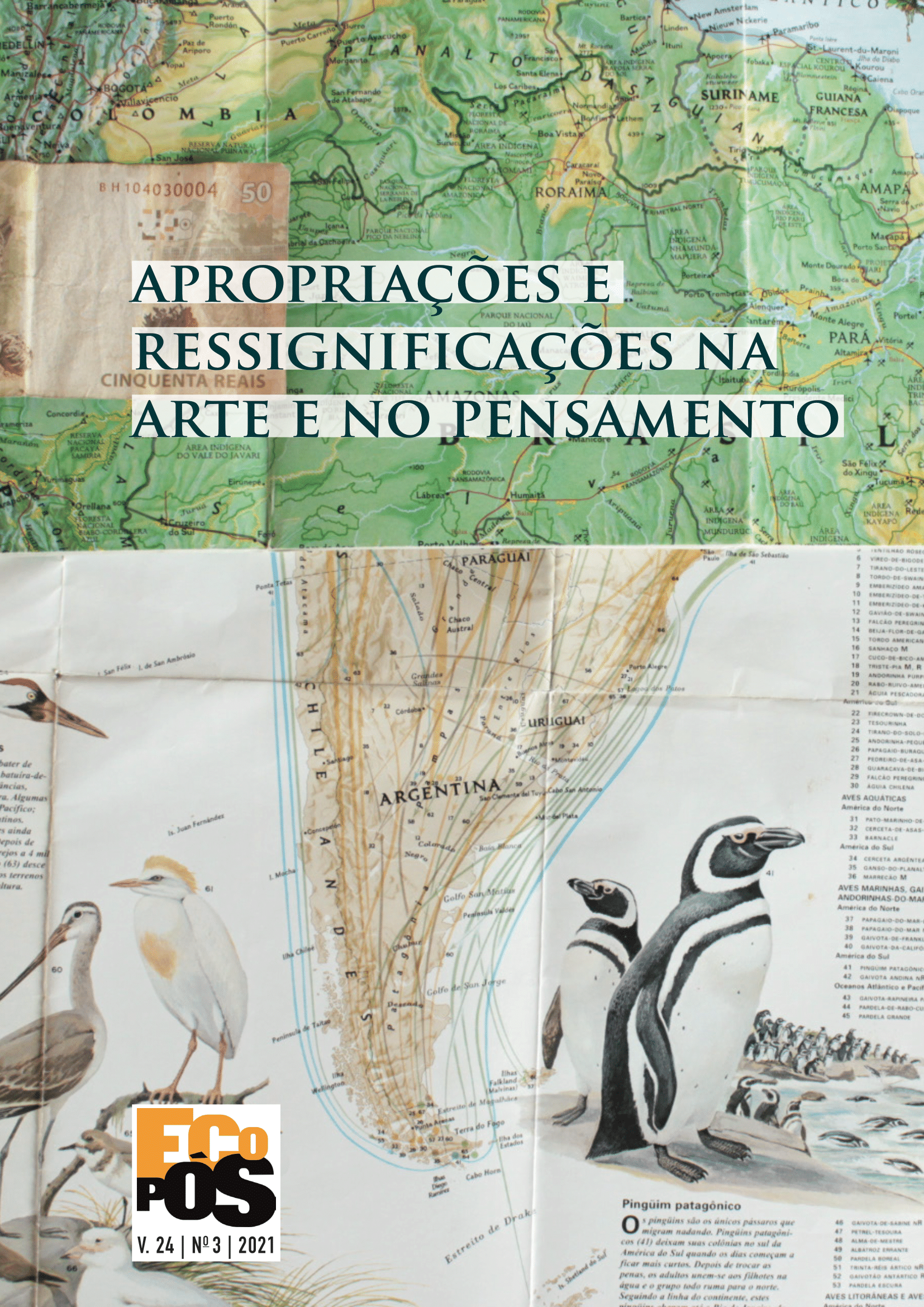Fotocopiar fotocópias na fotocopiadora
Apropriação e ressignificação de meios, materiais e processos
DOI:
https://doi.org/10.29146/ecopos.v24i3.27746Keywords:
electrography, copy art, collage, détournementAbstract
As practices of material appropriation, signic reframing, and performative ressignification, electrography and copy art directly call into question the concepts of original and copy. The goal of this article is to outline how these copy-based artistic practices promote a dialogue with the 20th-century widely spread notion of collage, dealing as well with the concept of “détournement” as a way of describing the radical gesture of appropriation and ressignification present in several works produced by Portuguese artists.
Downloads
References
ALCALÁ, José Ramón (Org.). Ars & Machina: Electrografía artística en la colección MIDE. Santander: Fundación Marcelino Botín, 1998.
ALCALÁ, José Ramón & CANALES, Fernando Ñiguez. Copy-Art: La fotocopia como soporte expresivo. Alicante: Instituto de Estudios Juan Gil-Albert / Centro Eusebio Sempere de Arte y Comunicación Visual, 1986.
ALCALÁ, José Ramón & ESCRIBANO, Beatriz. Museo Internacional de Electrografía Centro de Innovación en Arte y Nuevas Tecnologías de Cuenca. Cuenca: Ediciones de la Universidad de Castilla-La Mancha, 2016.
ALCALÁ, José Ramón & PASTOR, Jesús (Org.). Electrografías: Colección del Museo Internacional de Electrografía. Cuenca: Universidad Castilla-La Mancha, 1991.
AMERIKA, Mark. remixthebook. Minneapolis: University of Minnesota Press, 2011.
ARAGÃO, António. “Intervenção e movimento”. Poesia Experimental - Suplemento especial do Jornal do Fundão. Fundão: [s.n.], 1965.
ARAGÃO, António. “O público e as novas morfologias”. Búzio, n. 1, p. 24–26, 1956.
ARAGÃO, António. “Tecnologia, arte e sociedade”. In: AGUIAR, F.; ZINK, R.; MELO E CASTRO, E. M. DE (Org.). 1.o Festival Internacional de Poesia Viva. Figueira da Foz: Museu Municipal Dr. Santos Rocha, 1987. p. 145–151.
BRUNET-WEINMANN, Monique. Medium: Photocopy. Canadian and German copygraphy. Montreal: Goethe Institut Montreal / Centre Saidye Bronfman / Centre Copier Art inc., 1987.
DEBORD, Guy & WOLMAN, Gil. “A User’s Guide to Détournement”. Disponível em: http://www.bopsecrets.org/SI/detourn.htm.
DWORKIN, Craig Douglas. Reading the Illegible. Evanston, Ill: Northwestern University Press, 2003.
ESCRIBANO BELMAR, Beatriz. “The unknown and forgotten role of the photocopy machine transgressed as a creative tool”. In: CSF SUMMER SEMINAR AT MONTE VERITÀ, SWITZERLAND. Monte Verità, Switzerland: [s.n.], August 2018. p. 79–84.
FIRPO, Patrick; LESTER, Alexander & KATAYANAGI, Claudia. Copy Art: The First Complete Guide to the Copy Machine. Nova Iorque: Richard Marek Publishers, 1978.
GONZALEZ, Marisa. “Motion and metamorphosis”. Leonardo, v. 23, n. 2/3, p. 295–300, 1990.
GUNKEL, David J. Of Remixology: Ethics and aesthetics after remix. Cambridge, Massachusetts / London, England: The MIT Press, 2016.
HEMMUNGS WIRTÉN, Eva. No Trespassing: Authorship, intellectual property rights, and the boundaries of globalization. Toronto; Buffalo: University of Toronto Press, 2004.
HOME, Stewart. The Assault on Culture: Utopian currents from Lettrisme to class war. 2nd edition. Edinburgh: AK Press, 1991.
INTERNATIONALE SITUATIONNISTE. “Definitions — Internationale Situationniste #1” (June 1958). Disponível em: https://www.cddc.vt.edu/sionline///si/definitions.html.
KRAUSS, Rosalind E. The Originality of the Avant-Garde and Other Modernist Myths. Second printing ed. Cambridge, Mass: MIT Press, 1985.
MCCRAY, Marilyn. Electroworks. Rochester, New York: International Museum of Photography at George Eastman House, 1979.
MCLEOD, Kembrew & KUENZLI, Rudolf E. (Org.). Cutting Across Media: Appropriation art, interventionist collage, and copyright law. Durham [N.C.]: Duke University Press, 2011.
NELOS, António. “Entrevista em vídeo a António Nelos”. Funchal: Lonarte, 2011. Disponível em: https://www.youtube.com/watch?v=bmRj1p9GMkQ.
NELOS, António. “Introdução”. In: FIGUEIREDO, C. & NELOS, A. (Org.). Electrografias. Setúbal: Casa do Bocage – Galeria Municipal de Artes Visuais, 1991.
PASTOR, Jesús. “El procedimiento electrográfico en la creación artística”. In: ALCALÁ, J. R.; PASTOR, J. (Org.). Electrografías: Colección del Museo Internacional de Electrografía. Cuenca: Universidad Castilla-La Mancha, 1991. p. 17–25.
PIMENTA, Alberto. “Toque e Introdução”. In: FIGUEIREDO, C. cartas comerciais tipo. Porto: Edições Mortas, 1998. p. 7–8.
RIGAL, Christian. “Le point sur l’electrographie.” In: DARDAI, Z. (Org.). Árnyékkötők: Copy art, fax art, computer art. Budapeste: Árnyékkötők Foundation, 2005. p. 61–65.
SANTA CLARA, Isabel. Colectiva. Funchal: Galeria Porta 33, 1993.
SANTOS, Abílio-José. fotocirurgiando. S.L.: Ed. Autor, 1987. Disponível em: https://po-ex.net/taxonomia/materialidades/planograficas/abilio-fotocirurgiando/.
SHANKEN, Edward. Art and Electronic Media. New York: Phaidon, 2009.
WARK, McKenzie. The Beach Beneath the Street: The everyday life and glorious times of the Situationist International. London; New York: Verso, 2011.
Downloads
Published
How to Cite
Issue
Section
License
Copyright (c) 2021 Revista ECO-Pós

This work is licensed under a Creative Commons Attribution 4.0 International License.
Aos autores pertence o direito exclusivo de utilização ou reprodução.
Você tem o direito de:
- Compartilhar — copie e redistribua o material em qualquer meio ou formato.
- Adaptar — remixar, transformar e construir sobre o material para qualquer filme, mesmo comercial.
O licenciante não pode revogar esses direitos, desde que você respeite os termos da licença.
De acordo com os seguintes termos:
- Atribuição — Você deve dar o devido crédito, fornecer um link para a licença e indicar se essas alterações foram feitas. Você pode fazê-lo de qualquer maneira razoável, mas não de maneira que sugira que o licenciante endosse ou aprove seu uso.
- Sem restrições adicionais — Você não pode aplicar termos legais ou medidas de natureza tecnológica que restrinjam legalmente outros de fazer algo que a licença permite.
Aviso: A licença pode não fornecer todas as permissões necessárias para o uso pretendido. Por exemplo, outros direitos, como publicidade, privacidade ou direitos morais, podem limitar a maneira como você usa o material.











